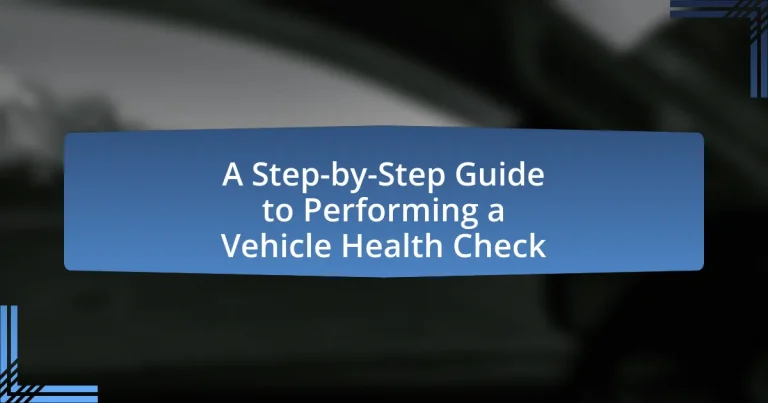A Vehicle Health Check is a thorough assessment of a vehicle’s condition, focusing on critical components such as the engine, brakes, tires, lights, and fluid levels. This guide outlines the importance of regular checks for ensuring safety, reliability, and efficiency, while also highlighting the risks associated with neglecting maintenance. Key components and systems inspected during a health check are detailed, along with the steps involved in performing one, factors influencing frequency, and best practices for maintaining vehicle performance. Additionally, the article provides insights on recognizing warning signs, conducting DIY checks, and the financial benefits of proactive vehicle maintenance.

What is a Vehicle Health Check?
A Vehicle Health Check is a comprehensive assessment of a vehicle’s condition, designed to identify any potential issues that may affect its performance and safety. This check typically includes an inspection of critical components such as the engine, brakes, tires, lights, and fluid levels. Regular Vehicle Health Checks can help prevent costly repairs and ensure that the vehicle operates efficiently, as studies show that proactive maintenance can extend a vehicle’s lifespan and improve fuel efficiency.
Why is a Vehicle Health Check important?
A Vehicle Health Check is important because it ensures the safety, reliability, and efficiency of the vehicle. Regular checks can identify potential issues before they escalate into serious problems, thereby reducing the risk of breakdowns and accidents. According to the National Highway Traffic Safety Administration, regular vehicle maintenance can prevent up to 75% of vehicle-related accidents caused by mechanical failures. This proactive approach not only enhances the vehicle’s performance but also extends its lifespan, ultimately saving owners money on repairs and improving fuel efficiency.
What are the potential risks of neglecting a Vehicle Health Check?
Neglecting a Vehicle Health Check can lead to severe risks, including mechanical failures, safety hazards, and increased repair costs. Mechanical failures may occur due to undetected issues such as worn brakes or low fluid levels, which can result in breakdowns. Safety hazards arise when critical components like tires or lights are not functioning properly, increasing the likelihood of accidents. Additionally, ignoring regular checks can lead to more extensive damage over time, resulting in higher repair costs; for instance, a small oil leak can escalate into a major engine problem if not addressed promptly. Regular vehicle health checks are essential for maintaining vehicle performance and ensuring driver and passenger safety.
How can regular Vehicle Health Checks save money in the long run?
Regular Vehicle Health Checks can save money in the long run by identifying and addressing potential issues before they escalate into costly repairs. Preventive maintenance, such as checking fluid levels, brakes, and tire conditions, can enhance vehicle performance and fuel efficiency, ultimately reducing operational costs. According to the American Automobile Association (AAA), regular maintenance can save drivers up to $1,200 annually by preventing major breakdowns and extending the lifespan of the vehicle. By investing in routine checks, vehicle owners can avoid unexpected expenses and ensure their vehicles operate optimally, leading to significant long-term savings.
What are the key components of a Vehicle Health Check?
The key components of a Vehicle Health Check include the inspection of the engine, brakes, tires, lights, fluids, and battery. Each component plays a crucial role in ensuring the vehicle operates safely and efficiently. For instance, the engine check assesses performance and emissions, while brake inspection evaluates stopping power and safety. Tire checks ensure proper tread depth and inflation, which are vital for traction and fuel efficiency. Light inspections confirm that all exterior and interior lights function correctly for visibility and safety. Fluid checks, including oil, coolant, and brake fluid, are essential for maintaining optimal engine performance and preventing overheating. Lastly, the battery check ensures reliable starting and electrical system functionality. These components collectively contribute to the overall health and safety of the vehicle.
What systems are typically inspected during a Vehicle Health Check?
During a Vehicle Health Check, the systems typically inspected include the engine, brakes, tires, lights, battery, and fluid levels. These components are crucial for ensuring the vehicle’s overall safety and performance. For instance, the engine inspection assesses its operational efficiency, while brake checks evaluate stopping power and safety. Tire inspections focus on tread depth and pressure, which are vital for traction and handling. Additionally, lights are checked for functionality to ensure visibility, the battery is tested for charge and health, and fluid levels (such as oil, coolant, and brake fluid) are monitored to prevent mechanical failures.
How do these components contribute to overall vehicle performance?
Vehicle components such as the engine, transmission, brakes, and suspension significantly contribute to overall vehicle performance by ensuring efficient power delivery, control, safety, and ride comfort. The engine generates power, which is transmitted through the transmission to the wheels, affecting acceleration and speed. For instance, a well-tuned engine can improve fuel efficiency and responsiveness, while a malfunctioning transmission can lead to poor acceleration and shifting issues.
Brakes are crucial for safety and performance, as they determine stopping distance and control during deceleration. Effective brakes enhance driver confidence and vehicle handling. Suspension systems impact ride quality and stability, allowing the vehicle to absorb road imperfections and maintain tire contact with the road, which is essential for traction and control.
Research indicates that regular maintenance of these components can lead to a 10-20% improvement in fuel efficiency and a significant reduction in accident rates due to better braking performance. Thus, the condition and functionality of these components directly influence the overall performance and safety of the vehicle.
How often should a Vehicle Health Check be performed?
A Vehicle Health Check should be performed at least once a year. Regular annual checks help identify potential issues before they become serious problems, ensuring the vehicle remains safe and reliable. According to the Vehicle and Operator Services Agency (VOSA), annual inspections can significantly reduce the likelihood of breakdowns and costly repairs, thereby enhancing vehicle longevity and performance.
What factors influence the frequency of a Vehicle Health Check?
The frequency of a Vehicle Health Check is influenced by several key factors, including the vehicle’s age, mileage, driving conditions, and manufacturer recommendations. Older vehicles typically require more frequent checks due to wear and tear, while higher mileage can indicate a greater need for maintenance. Additionally, driving in harsh conditions, such as extreme temperatures or rough terrain, can accelerate wear, necessitating more regular health checks. Manufacturer guidelines often provide specific intervals for checks based on the vehicle model, which should be adhered to for optimal performance and safety.
How does driving style affect the need for regular checks?
Driving style significantly influences the need for regular vehicle checks. Aggressive driving, characterized by rapid acceleration, hard braking, and high-speed cornering, can lead to increased wear and tear on critical components such as brakes, tires, and the engine. For instance, studies indicate that aggressive drivers may experience brake pad wear up to 50% faster than those who drive conservatively. Conversely, a smooth and cautious driving style typically results in less strain on the vehicle, thereby reducing the frequency and urgency of maintenance checks. Regular checks become essential for aggressive drivers to ensure safety and vehicle longevity, as neglecting maintenance can lead to costly repairs and increased risk of accidents.
What steps are involved in performing a Vehicle Health Check?
Performing a Vehicle Health Check involves several key steps: first, inspect the exterior for any visible damage or wear; second, check the fluid levels including oil, coolant, and brake fluid; third, examine the tires for tread depth and pressure; fourth, assess the battery condition and connections; fifth, test the lights and indicators; sixth, evaluate the brakes for responsiveness; seventh, review the dashboard warning lights; and finally, conduct a road test to assess overall performance. Each of these steps ensures that the vehicle is safe and functioning properly, contributing to its longevity and reliability.
How do you prepare for a Vehicle Health Check?
To prepare for a Vehicle Health Check, ensure that your vehicle is clean and accessible, as this allows for a thorough inspection. Additionally, gather any relevant documentation, such as the vehicle’s service history and previous inspection reports, which can provide valuable context for the technician. Checking fluid levels, tire pressure, and battery condition beforehand can also facilitate a smoother process. According to the National Highway Traffic Safety Administration, regular maintenance and checks can prevent up to 75% of vehicle breakdowns, highlighting the importance of preparation.
What tools and equipment are necessary for a thorough check?
A thorough vehicle health check requires essential tools and equipment such as an OBD-II scanner, tire pressure gauge, multimeter, fluid inspection tools, and basic hand tools like wrenches and screwdrivers. The OBD-II scanner is crucial for diagnosing engine issues by reading error codes, while a tire pressure gauge ensures tires are properly inflated for safety and efficiency. A multimeter is necessary for checking electrical systems, and fluid inspection tools help assess the condition of engine oil, coolant, and brake fluid. Basic hand tools are needed for any adjustments or repairs identified during the check. These tools collectively enable a comprehensive evaluation of a vehicle’s health, ensuring all critical systems are functioning correctly.
What common issues can be identified during a Vehicle Health Check?
Common issues identified during a Vehicle Health Check include low fluid levels, worn brake pads, tire wear, and battery health concerns. Low fluid levels, such as engine oil or coolant, can lead to engine overheating or damage. Worn brake pads can compromise braking efficiency, increasing the risk of accidents. Uneven tire wear may indicate alignment issues, affecting vehicle handling and safety. Additionally, battery health concerns can lead to starting problems, especially in extreme weather conditions. Regular checks can prevent these issues, ensuring vehicle safety and performance.
How can you recognize warning signs before they become serious problems?
To recognize warning signs before they become serious problems, regularly monitor your vehicle for unusual noises, warning lights, and changes in performance. These indicators often signal underlying issues; for instance, a check engine light can indicate engine problems that, if ignored, may lead to costly repairs. Additionally, pay attention to fluid leaks, tire wear, and brake responsiveness, as these can also signify potential failures. According to the National Highway Traffic Safety Administration, regular vehicle maintenance can prevent 80% of vehicle breakdowns, highlighting the importance of early detection of warning signs.
What are the most frequently reported issues found during checks?
The most frequently reported issues found during vehicle health checks include low fluid levels, worn brake pads, and tire wear. Low fluid levels, such as engine oil and coolant, can lead to engine overheating and damage. Worn brake pads compromise braking efficiency, increasing the risk of accidents. Tire wear affects traction and handling, which can lead to unsafe driving conditions. These issues are commonly identified during routine inspections, emphasizing the importance of regular vehicle maintenance to ensure safety and performance.
How can you ensure a successful Vehicle Health Check?
To ensure a successful Vehicle Health Check, conduct a thorough inspection of all critical systems, including the engine, brakes, tires, and fluid levels. This comprehensive approach allows for the identification of potential issues before they escalate into serious problems. According to the National Highway Traffic Safety Administration, regular vehicle maintenance can reduce the likelihood of breakdowns by up to 50%. Additionally, utilizing diagnostic tools can provide real-time data on vehicle performance, enhancing the accuracy of the health check.
What best practices should be followed during the check?
During a vehicle health check, best practices include conducting a thorough inspection of all critical components, such as the engine, brakes, tires, and fluid levels. This ensures that any potential issues are identified early, which can prevent costly repairs and enhance safety. For instance, checking tire pressure and tread depth can significantly impact vehicle performance and fuel efficiency, as improper tire conditions can lead to increased wear and reduced handling. Additionally, documenting findings and maintaining a checklist can help track maintenance history and ensure that no aspect of the vehicle is overlooked. Following these practices aligns with industry standards, as recommended by organizations like the National Highway Traffic Safety Administration, which emphasizes regular vehicle inspections for optimal safety and performance.
How can you maintain your vehicle between health checks?
To maintain your vehicle between health checks, regularly inspect and address essential components such as oil levels, tire pressure, and brake functionality. Checking oil levels ensures the engine runs smoothly, as low oil can lead to severe engine damage. Maintaining proper tire pressure enhances fuel efficiency and safety, while ensuring brakes are functioning correctly is crucial for safe driving. According to the National Highway Traffic Safety Administration, proper vehicle maintenance can reduce the risk of accidents and extend the vehicle’s lifespan.
What are some tips for conducting a DIY Vehicle Health Check?
To conduct a DIY Vehicle Health Check, start by gathering essential tools such as a tire pressure gauge, oil dipstick, and a flashlight. Check tire pressure and tread depth to ensure safety and performance; under-inflated tires can reduce fuel efficiency by up to 3%. Inspect fluid levels, including engine oil, coolant, and brake fluid, as low levels can lead to engine damage or brake failure. Examine the battery for corrosion and ensure connections are tight, as a weak battery can lead to starting issues. Finally, test all lights and signals to ensure visibility and compliance with road safety regulations. Regular checks can prevent costly repairs and enhance vehicle longevity.


